All published articles of this journal are available on ScienceDirect.
The Perception of Smile Attractiveness among Female Students of Herat University, Herat, Afghanistan, 2024
Abstract
Introduction
Having a beautiful smile affects social relationships, career achievement, and personality development. Everyone has a different opinion of how attractive a smile is.
Aim
This study aimed to assess information about the perception of smile attractiveness toward different characteristics of smiles among students of Herat University.
Methods
A comprehensive descriptive cross-sectional study was conducted on 215 female students from 17 different faculties of Herat University. A questionnaire with two main sections was prepared: The demographic information section and the questions section with prepared questions about the perception of smile attractiveness toward different characteristics of smiles. The participants answered the questions by themselves or the interviewer.
After coding the answers, the questionnaire was categorized according to the answers, interred, and analyzed using IBM-SPSS version 25 (SPSS, version 25, IBM Corp).
The chi-square test was performed to compare descriptive data, such as frequencies, with qualitative data. p-values smaller than 0.05 were considered significant.
Results
The most attractive smile according to different characteristics of a smile was a low smile (50.93%), consonant smile arc (48.11%), commissure smile type (52.09%), classic marginal shape (79.53%), displaying teeth up to the second premolar (47.44%), straight upper lip curvature (64.19%) and a slightly touching relationship of maxillary anterior teeth with the lower lip (51.63%).
Conclusion
To achieve satisfactory outcomes in oral rehabilitation, dentists should always bear in mind that everyone has a different opinion of how attractive a smile is and that each case needs to be evaluated separately while taking the patient's expectations and preferences into account.
1. INTRODUCTION
Aesthetics have been increasingly important in modern restorative dentistry, and they are associated with a natural, harmonious appearance. An appealing or charming smile certainly increases acceptance. A smile is a common facial expression that conveys happiness, kindness, and appreciation. The patient's desire for aesthetics frequently drives them to seek dental care. However, beauty is not absolute and is highly subjective. It is frequently influenced by cultural or ethnic influences and individual preferences [1].
In determining face attractiveness, dental appearance is a crucial component that has a big impact on social interactions in human life [2]. Humans have been fascinated by the aesthetics of teeth for 2,000 years, however, the definitions of dental beauty have changed over time and between cultures [3]. These days, people are interested in learning more about their alternatives for additional cosmetic treatment as well as the attractiveness and appearance of their teeth. Therefore, the creation of appealing smiles requires an understanding of the elements that contribute to or detract from a smile's beauty. To ensure that physicians can apply these norms and standards to diagnostic procedures and aesthetic treatment plans and produce the desired “golden smile,” a study of beauty standards and norms is conducted [4].
The hard-tissue component of a smile, the teeth, as well as the degree of gingival show and lip framing all work together to create an appealing smile [5-8]. Gingival contours have been the subject of numerous recent studies to quantify gingiva-related factors, and the findings of these investigations are extremely pertinent to clinical dentistry practice. The clinical criteria of interdental gingiva height, gingival zenith (GZ) point position, gingival line direction, and gingival symmetry are significant in addition to healthy gingiva characteristics. It is imperative to take gingival aesthetics into account during treatment planning in order to anticipate outcomes and attain the best possible results in gingival contour rehabilitation [9, 10].
Studies have indicated that having a beautiful smile affects social relationships, career achievement, and personality development [11]. In the diagnosis and treatment planning stages of aesthetic and prosthodontic dentistry, a smile analysis is essential. A smile can be roughly classified as either deliberate (posed) or involuntary (spontaneous) based on neurological control. An involuntary smile is associated with feelings, while a posed (social) smile is deliberate and typically unrelated to feelings [12-14]. The components that make up a person's natural smile are numerous. These include the position of the incisal edge, buccal corridor, labiodental relationship, teeth presentation, smile line, smile arc, and smile design. A smile's aesthetic evaluation also takes into account the gingival display, gingival zenith position, symmetry, and dental-facial midline. While creating a smile makeover, each of these elements needs to be considered [15].
When someone speaks in a social setting, a lot of attention is drawn to their mouth and eyes. The most noticeable aspect of facial attractiveness is the oral region of the face while it is smiling, which is an expression of satisfaction [16]. A person's smile greatly influences their self-perception and is a crucial component of their physical beauty and facial expression [17].
According to a study by Dunn et al., tooth shade was found to be the most significant component of an aesthetically pleasing smile, followed by the number of teeth visible and the presence of natural teeth free of restorations [18]. There may not be a perfect smile, but attaining a balanced smile, which is defined as properly positioned teeth, including in relation to the soft tissues of the gingiva, is the most crucial aesthetic goal [19].
This study was initiated to evaluate the perception of smile attractiveness among female students of different faculties of Herat University against the background of their knowledge about a perfect or ideal smile.
2. MATERIALS AND METHODS
This comprehensive descriptive cross-sectional study, meticulously conducted over one month from February to April 2024, aimed to gather detailed information about the perception of smile attractiveness toward different characteristics of smiles among the esteemed students of Herat University. The study protocol, identified as 38014022024, received ethical approval from the ethical committee of faculty of medical science at Herat University before data collection commenced on January 25, 2024.
Our study was meticulous in its participant selection. The inclusion criteria were carefully defined as female students of Herat University with no disabilities and a willingness to cooperate. Conversely, the exclusion criteria were equally stringent, excluding male students, those with any disability, and students from other universities who were not willing to cooperate.
According to the Student Affairs Department of Herat University, the population of female students from February to April 2024 was 485 people. Among all Herat University female students, by using the Raosoft sample size calculator website (http://www.raosoft.com/samplesize.html) and choosing a 5% margin of error, 95% confidence level, and 50% response distribution, a 215-person sample size was detected and divided into 17 faculty of Herat University according to each faculty population.
Informed consent was taken from all the participants. The participant signed the consent form after a short, direct interview and discerption about the study. A questionnaire with two main sections was prepared: The demographic information section (age, educational field, marital status, and habitation) and the question section with prepared questions about information about the perception of smile attractiveness toward different characteristics of smiles among students of Herat University.
The study was conducted in the 17 faculties of Herat University with a direct, face-to-face interview. Before starting the interview and asking the questions, a short introduction and information about types of smile design were demonstrated. Then, the participants answered the questions by themselves or the interviewer.
After coding the answers, the questionnaire was categorized according to the answers, interred, and analyzed using IBM-SPSS version 25 (SPSS, version 25, IBM Corp).
The chi-square test was performed to compare descriptive data, such as frequencies, with qualitative data. p-values smaller than 0.05 were considered significant.
3. RESULTS
This research was carried out with the participation of 215 students ranging in age from 18 to 28 (M = 21.34, SD = 2.003) from different faculties of Herat University to obtain information about the perception of smile attractiveness toward different characteristics of smile among students of Herat University. The following results were obtained.
According to the smile line or elevation of the upper lip about the maxillary incisors when smiling (Fig. 1), almost half of the students (50.93%) chose a low smile, 34.58% chose an average smile and 14.49% chose a high smile as the most attractive smile (Fig. 2). A statistically significant difference between single and married respondents was observed (p-value <0.05); we found that majority of single people accepted average smile as the most attractive smile when compared with married people. When perceptions of students from various faculties were compared, a statistically significant difference (p-value <0.05) was also observed, indicating that most participants from law and politics, engineering, counseling, and biology faculties chose a low smile as the most attractive smile. In contrast, most participants from English literature, stomatology, and agriculture accepted an average smile as the most attractive smile.
For smile arc (Fig. 3), 48.11% of the participants selected consonant smile, followed by straight non-consonant smile (41.51%) and reverse non-consonant smile (10.38%) as the most attractive smiles (Fig. 4).

Basic characteristics of smile. (A) High Smile line, (B) Average Smile line, (C) Low Smile line.

The perception of students toward smile line according to its attractiveness.
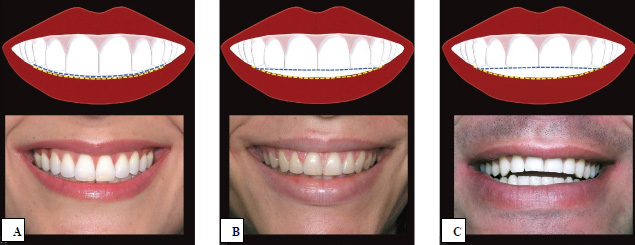
Basic characteristics of smile. (A) Consonant Smile arc, (B) Straight Smile arc, (C) Reverse Smile arc.

The perception of students toward smile arc according to its attractiveness.

(A) Cuspid Smile type, (B) Commissure Smile type, (C) Complex Smile type.
Based on the design or type of smile (Fig. 5), 52.09% of the 215 participants chose the commissure smile, 39.53% chose the cuspid smile, and 8.37% chose the complex smile type as the most attractive smile (Fig. 6).
Regarding the most beautiful margin design (Fig. 7), the majority of participants (79.53%) chose the classic shape, and a few participants (20.47%) chose the modified shape (Fig. 8).
Regarding the number of teeth displayed (Fig. 9), 47.44% of the participants believed that displaying teeth up to the second premolar is the most attractive. In comparison, 27.91% of them chose to display teeth up to the first premolar, 24.65% of them decided to display teeth up to the first molar, and 1.86% of them chose to display teeth up to canine as the most attractive smile (Fig. 10). The association between students’ age differences and the perception toward number of teeth displayed was found to be significant (p-value <0.05). Participants aged 20-23 accepted wearing teeth up to the second premolar as the most attractive smile more than other age groups. When perceptions of students from different faculties were compared, a statistically significant difference (p-value <0.05) was also found, indicating that all respondents from the Stomatology faculty and the majority of participants from engineering, counseling, and biology faculties accepted displaying teeth up to the second premolar as the most attractive smile more than other students.
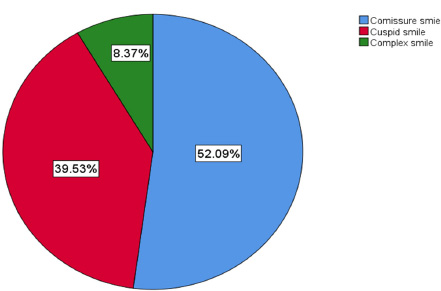
The perception of students toward smile design according to its attractiveness.
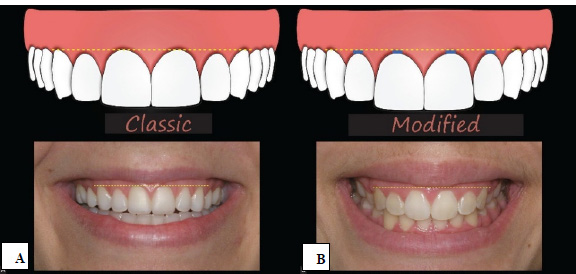
Margin design. (A) classic shape, (B) modified shape.
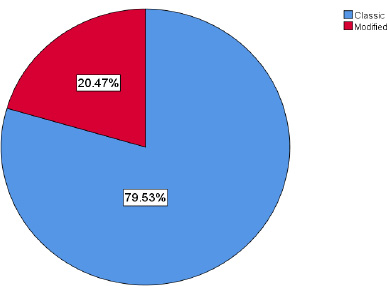
The perception of students toward margin design according to its attractiveness.
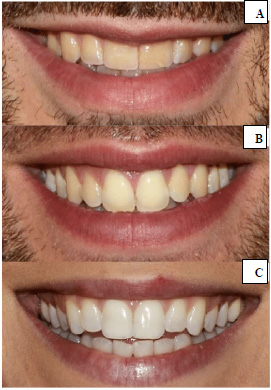
Additional characteristics of smile. (A) Teeth displayed up to first premolars, (B) Teeth displayed up to second premolars, (C) Teeth displayed up to first molars.
Regarding the upper lip curvature (Fig. 11), straight upper lip curvature was selected by 64.19% of students, upward upper lip curvature was chosen by 26.05% of them, and downward upper lip curvature was selected by 9.77% of them as the most attractive smile (Fig. 12).
According to the labiodental relationship of the lower lip and maxillary anterior teeth (Fig. 13), 51.63% of the participants chose a slightly touching relationship of maxillary anterior teeth with the lower lip, 37.67% of them decided not-touching relationship of maxillary anterior teeth with lower, and 10.70% of them chose a state of maxillary anterior teeth covered by lower lip as the most attractive smile (Fig. 14).
4. DISCUSSION
This study aimed to assess information about the perception of smile attractiveness toward different characteristics of smiles among students of Herat University. A comprehensive descriptive cross-sectional study was conducted on 215 students from 17 different faculties of Herat University.
The research showed that among 215 participants, according to the smile line, almost 50.93% of students chose a low smile, 34.58% chose an average smile, and 14.49% chose a high smile as the most attractive smile. In a research conducted by Melo et al. [20] in 2020 in Spain, photographs were obtained under resting and forced smiling conditions in 140 individuals (70 males and 70 females) with a mean age of 20.1 ± 4.3 years: Most of the patients (84.3%; n = 118) presented a medium smile line, 8.6% (n = 12) a low smile line, and 7.1% (n = 10) a high smile line. According to gender, females presented a high smile line more often than males (11.4% versus 2.9%, respectively), which was the opposite of our outcome. In a research conducted by Arroyo-Cruz et al. [21] in 2021, 144 dental students from the University of Seville in Southern Europe, the chosen smile line was high at 25%, normal or average at 50%, and low at 11.8%, 2 of these study findings were in contrast with our outcomes.

The perception of students toward the number of teeth displayed according to its attractiveness.

Additional characteristics of smile. (A) Upward Upper lip curvature, (B) Straight Upper lip curvature, (C) Downward Upper lip curvature.

The perception of students toward upper lip curvature according to its attractiveness.
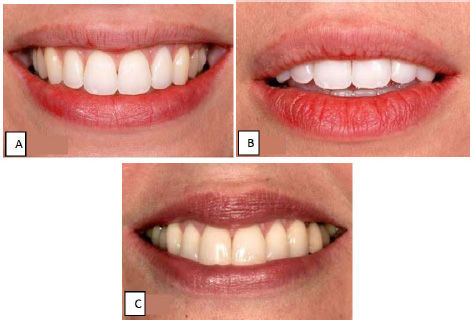
Additional characteristics of smile. (A) Lower lip slightly touching the maxillary anterior teeth, (B) Not-touching labiodental relationship, (C) Maxillary anterior teeth covered by lower lip.

The perception of students toward labiodental relationship of the lower lip and maxillary anterior teeth according to its attractiveness.
In an optimal smile arc described as “consonant,” the curvature of the maxillary incisal edges coincides with or parallels the border of the lower lip in smiling [22]. In a “non-consonant” smile arc, the maxillary incisal edges are either flat or reversed relative to the curvature of the lower lip [23, 24]. In this study, consonant smile arcs were selected by 48.11% of the participants, followed by straight non-consonant smile arcs 41.51%, and reverse non-consonant smile arcs (10.38%), which is similar to research conducted by Melo et al., in 2020, 80% (n = 112) presented a consonant arc of the smile, while the remaining 20% (n = 28) showed a non-consonant arc, our outcomes concur with those of janu et al. in 2020, in India, where most females with a parallel smile arc had an attractive smile while most females who did not have a parallel arc had an average to fair smile [25]. In research by Arroyo-Cruz et al., smile arc parallel was chosen by 47.2%, straight at 38.9%, and inverted at 13.9% [21], which is similar to our study. Another study conducted by Tjan et al. in 1984 showed a more remarkable 85% maxillary incisal smile curve parallel to the inner curvature of the lower lip; around 14% of cases presented a flat line instead of a curved line, and only 1% of cases showed an inverse smile curve [1], which is in accordance with our study, in the research conducted by Khan et al., in 2020 in Karachi, Pakistan, consonant smile arcs were more common for smile arcs, followed by flat or straight arcs [15], which concurs with our outcome.
The upper lip curvature is assessed from the central position to the corner of the mouth in smiling; It is upward when the corner of the mouth is higher than the central position, straight when the corner of the mouth and the central position is at the same level, and downward when the corner of the mouth is lower than the central position [26-29]. In the present study, straight upper lip curvature was selected by 64.19% of students, and upward upper lip curvature was selected by 26.05% of them. About 9.77% of them selected downward upper lip curvature as the most attractive smile; our outcome similarly concurs with those of Dong, J.K et al., [27] in 1999: Upward and straight lip curvatures are considered more esthetic than downward lip curvatures. In a non-orthodontic population with normal occlusions, upward lip curvatures were rare at 12%. However, straight 45% and downward 43% lip curvatures were almost equally prevalent [23], which does not match the result of our research. In a research conducted by Melo et al., a total of 47.1% of the patients (n = 66) had an upward lip curve, 41.4% (n = 58) had a straight curve, and 11.4% (n = 16) presented a downward upper lip curve (p = 0.315) [20], which is consistent with the result of our study. In the research by Khan et al., upward lip curvature was observed in most individuals, followed by an equal distribution of downward and straight lip curvatures [15].
According to the labiodental relationship of the lower lip and maxillary anterior teeth, 51.63% of the participants chose a slightly touching relationship of maxillary anterior teeth with lower lip, 37.67% of them decided a not-touching relationship of maxillary anterior teeth with lower, and 10.70% of them chose a state of maxillary anterior teeth covered by lower lip as the most attractive smile and in a research done by Arroyo-Cruz et al., Incisal, edges, and lower lip position touched 29.2%, not touching 63.2%, overlapping 7.6% [21], which does not match the result of our research.
In the present study, about the number of teeth displayed, 47.44% of the participants believed that displaying teeth up to the second premolar is the most attractive. In comparison, 27.91% of them chose to display teeth up to the first premolar, and 24.65% of them decided to display teeth up to the first molar as the most attractive smile; in the research conducted by Khan et al., teeth displayed up to first premolars among the majority of subjects, with few participants having their first molars visible during a smile [15], which is opposite the result of our study. In studies conducted by Tjan, et al., in the smiles of young subjects with normal occlusions, a first molar display was found in only 3.7% of one sample; however, with most of the subjects (57%) displaying only the second premolars [1], which concur the result with our outcome.
In the present study, based on the design or type of smile, among all 215 participants, 52.09% chose the commissure smile, 39.53% chose the cuspid smile, and 8.37% chose the complex smile as the most attractive smile. In the research conducted by Khan et al., the most common smile type observed was cuspid, followed by commissure and then complex smile type [15], which does not match the result of our research.
Non-extraction treatment with maxillary expansion does not necessarily improve the smile's attractiveness. Research has shown that premolar extraction does not lead to arch constriction or a widening of buccal corridors [30].
CONCLUSION
Perception of smile attractiveness according to different characteristics of a smile from the most to the least attractive was as follows:
- Smile line: Low smile, average smile and high smile
- Smile arcs: Consonant smile, straight non-consonant smile and reverse non-consonant smile
- Margin design: Classic shape, modified shape
- Design of smile: Commissure smile, cuspid smile and complex smile
- Number of teeth displayed: Up to the second premolar, up to the first premolar and up to the first molar.
- Labiodental relationship of the lower lip and maxillary anterior teeth: Slightly touching, not-touching and maxillary anterior teeth covered by the lower lip
- Upper lip curvature: Straight, upward and downward
The most attractive smile, according to different characteristics of a smile, was a low smile, consonant smile arc, commissure smile type, classic marginal shape, displaying teeth up to the second premolar, straight upper lip curvature and a slightly touching relationship of maxillary anterior teeth with the lower lip.
These findings can be used to analyze people's smiles before they undergo aesthetic treatment. Furthermore, to achieve satisfactory outcomes in oral rehabilitation, dentists should always bear in mind that everyone has a different opinion of how attractive a smile is and that each case needs to be evaluated separately while taking the patient's expectations and preferences into account.
AUTHORS’ CONTRIBUTION
It is hereby acknowledged that all authors have accepted responsibility for the manuscript's content and consented to its submission. They have meticulously reviewed all results and unanimously approved the final version of the manuscript.
ABBREVIATION
| GZ | = Gingival zenith |
ETHICS APPROVAL AND CONSENT TO PARTICIPATE
The study received ethical approval from the ethical committee of the faculty of medical science at Herat University, Afghanistan, before data collection commenced on January 25, 2024 (38014022024).
HUMAN AND ANIMAL RIGHTS
All human research procedures followed were in accordance with the ethical standards of the committee responsible for human experimentation (institutional and national), and with the Helsinki Declaration of 1975, as revised in 2013.
AVAILABILITY OF DATA AND MATERIALS
The data and supportive information are available within the article.
ACKNOWLEDGEMENTS
Declared none.


